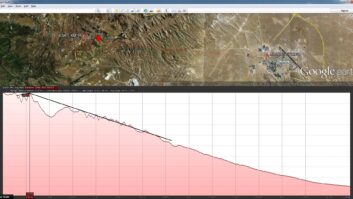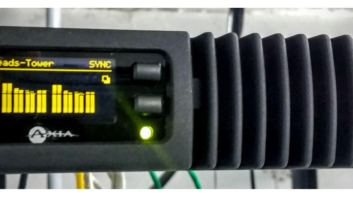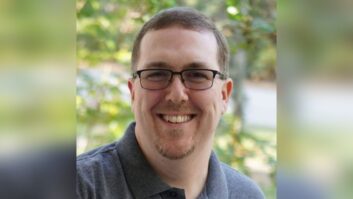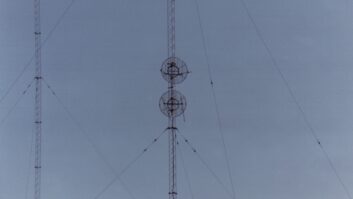• Monday morning April 16:
“STL Bandwidth Requirements for Radio”• Monday afternoon April 16:
“Audio Solutions for Radio”by Tom Osenkowsky
By the first day of the workweek, NAB BEC sessions will be well under way.
Monday’s papers discuss studio-transmitter links in the morning and new digital audio technologies that enhance broadcasting requirements in the afternoon.
STL BANDWIDTH REQUIREMENTS FOR RADIO
The morning session is chaired by Milford Smith, vice president of engineering for Greater Media.
“In general, the three papers in this session deal with various aspects of connectivity in both the audio-over-IP arena as well as the integration of HD Radio, and particularly multicast applications, into the broadcast plant,” he said.
“These are largely new areas to most broadcast engineers and the insights which will be offered should be valuable to almost any technical person working in radio.”
“Audio Over IP: Can It Really Work?” – Kevin Campbell of APT, formerly European sales manager and now based in the United States, said, “We will look at IP links and the possibilities for broadcast-quality STL, contribution and distribution audio links. With the increasing amount of IP connectivity all around us, it is no surprise that broadcasters are looking to the medium to move their content around, be it for STL or remotes.”
However, he said, there are a number of pitfalls along the way to IP STL Nirvana.
“Make sure the network is fit for purpose, make sure the hardware can deal with the network conditions thrown at it and make sure the audio compression algorithm is suited to deal with the inherent delay of the packetized medium.”
With the popularity of IP as a medium for audio transport, the factors examined in this session are likely to be important in deciding if this avenue best suits a station’s requirements.
“E2X Bandwidth and Bit Error Requirements for Ethernet Synchronization; Introducing a Reliable Real-Time Point-to-Multipoint E2X Transport Protocol” – The most recent radio systems broadcast architecture by Ibiquity Digital Corp. allows IBOC content transfer to an IBOC-enabled exciter via generic IP-based data streams.
The requirements for high-quality audio transfer are more stringent than for arbitrary data. Factors such as packet loss requiring bit error rates, congestion and throughput delay can affect audio quality. While the TCP/IP protocol can mitigate packet loss by Automatic Repeat Requests (ARQ) on a low-bandwidth system, they are limited to a point-to-point operation with full-time synchronization between the two points.
Philipp Schmid, digital design engineer at Nautel Ltd., will talk about a new point-to-multipoint ARQ protocol tailored for the Gen 3 system. This will allow multiple receivers to request data from a common studio source. There will be a demonstration with main/standby IBOC exciter configurations and point-to-multipoint satellite networks which can be employed for IBOC distribution to multiple transmitter sites.
“Networking and STL Issues When Implementing Multicasting for HD” – A major benefit of HD FM is multicasting capability, which permits a broadcaster to offer additional programming. The rollout of multicasting, still in its early days, has offered lessons. The requirements for networking and required STL bandwidth will be examined.
Richard Hinkle, vice president of engineering and technical services for Broadcast Electronics Inc., will discuss case studies of stations that have implemented multicasting. These are intended to serve as a guide for stations wishing to multicast. He’ll talk about features and improvements in the latest importer as well as how it has addressed concerns of prior installations.
AUDIO SOLUTIONS FOR RADIO
The Monday afternoon radio session at the NAB Broadcast Engineering Conference will be chaired by Talmage Ball, vice president of engineering for Bonneville International. (Also held that day will be a session on audio solutions for television.)
“The session will focus on new digital audio technologies that enhance broadcasting requirements,” he said. “Digital audio is a mainstay in today’s world. Presenters will discuss audio-over-IP networks, audio compression techniques, digital audio voice synthesis, use of new satellite technology and improvements to blending made in time alignment.”
“High-Quality Speech Synthesis System Using Speech Rate Conversion for Stock-Price Bulletins” – Hiroyuki Segi of NHK/Japan Broadcasting, based in Tokyo, will address the development of a speech synthesis system that produces natural-sounding speech for reporting stock price bulletins.
“By modeling the effects of co-articulation, synthesized speech of numbers from 1 to 99,999,999 can be created from voice waveforms of only 4,000 utterances of numbers,” said Segi.
Advantages of synthesized speech are the elimination of human speech errors and the ability to realize natural-sounding delivery in a specific timeframe. The modeling technique offers possibilities in automation systems and other applications.
“Reliable Audio Transport Over IP Networks” – Discussing the technical challenges posed in transporting live, real-time audio streams over networks that were designed for non-real-time file transfers will be Bob Band, business development manager at Harris Corp.
“I’ll review the reliability-enhancing technical options available in the latest generation of audio codecs, as well as the different types of IP networks and which ones are best suited for carrying mission-critical traffic,” he said.
Band will co-present with Josh Sparks, head of product and service development for VT Communications, formerly Merlin Communications. Sparks will discuss experiences in setting up an international IP audio transport network that provides reliability equivalent to traditional T1/E1 networks, using a combination of Harris’s NetXpress IP audio multiplexer and Cable & Wireless’s MPLS network. The session will address hardware concerns such as the available types of networks, suitable equipment, packet loss and comparison to T1 technology.
“Sonic Tonic for Audio Coding” – “Achieving great-sounding coded audio is easier said than done,” says Frank Foti, president of Omnia Audio. “What are the critical elements that set apart great-sounding digital channels or streams, especially at lower bit rates?”
He says improving codec performance is accomplished through innovative signal conditioning and processing means. “Coded audio is now a way of life in the professional and consumer sound industry. It is commonplace in all forms of media that utilizes sound in one form or another.”
Foti’s presentation will investigate what transpires within the coded transmission system, where the stumbling blocks are and methods that provide smooth sonic sailing. Information regarding the causes of perceptible problems in audio coding and how to avoid them, along with a method that improves the sound quality of coded audio, are to be addressed. He’ll play samples of sound that present codec challenges before and after proper conditioning.
“Digital Radio – Audio & Beyond” is to be the topic of Rich Redmond, director of strategic marketing for Harris.
He said he’ll explore “the paradigm shift that radio is evolving from one program per transmitter to a multitude of programs per transmitter. This can mean multicasting such as HD Radio, DRM or DAB; it can be the distribution of data such as text like RBDS, with expanded capabilities on digital radio.” This may also include multimedia distribution for content over radio such as Mobile TV on DAB/DMB systems, enhanced graphics with HD Radio such as cover art, Redmond said.
“Audio Compression – Trade Offs Between Quality, Data Reduction and Latency” – The ability to decrease file size while retaining fidelity is the major tradeoff in audio compression techniques and will be addressed by Guy Gampell, Asian sales manager for APT.
Compression algorithms vary from psychoacoustic to ADPCM-based. Gampell will talk about issues such as latency, loss and concatenation, and he’ll present research data using theoretical and real-world latency figures, before and after compression comparisons of sample material and listening test comparisons after multiple encode/decode cycles.
He will examine new algorithms such as AAC HE and apt-X Live, as well as the question of whether compression is needed at all, given the popularity of IP and the availability of increased bandwidth.
“Radio Remotes Using New Satellite Technology” – Paul Shulins, director of technical operations for Greater Media Boston, addresses technology that can be used for radio broadcasters to get real-time audio from remote sites back to the studio from just about anywhere on earth.
“One of the biggest challenges radio broadcasters have faced over the years is the reliability and lead times in getting telephone circuits installed for broadcast use. With the decline of telephone services that are available in many areas (such as ISDN and equalized analog lines), phone service just isn’t what it used to be,” said Shulins.
“A new satellite service from Inmarsat called BGAN, coupled with either an ISDN codec or an IP codec, is now offering broadcasters an option to do a remote from just about anywhere on the planet, on a moment’s notice.” But he said, the flexibility comes at a cost. “My presentation will outline the pros and cons of this new technology, and will give a user report showing my experiences here in Boston.”
Shulins also points out the need for HD Radio stations to transport pre-delay audio to the remote site.
“IBOC Analog-Digital Blend Time Alignment Quality” – A unique feature of HD Radio is digital-analog audio blend. This requires precise time alignment of both audio chains.
Michael Bergman, vice president of new technologies for Kenwood, said, “Proper time alignment appears to be a key factor for good performance in signal fading conditions. Poor alignment leads to audible level shifts during blend, echo and comb-filter artifacts.”
His presentation looks at time-alignment measurement techniques and the resulting accuracy. It presents IBOC receiver alignment results across several brands, and considers audio quality issues.
Tom Osenkowsky is a consulting engineer based in Brookfield, Conn., and a long-time contributor to Radio World.
Monday: STL Bandwidth Requirements
By the first day of the workweek, NAB BEC sessions will be well under way.










